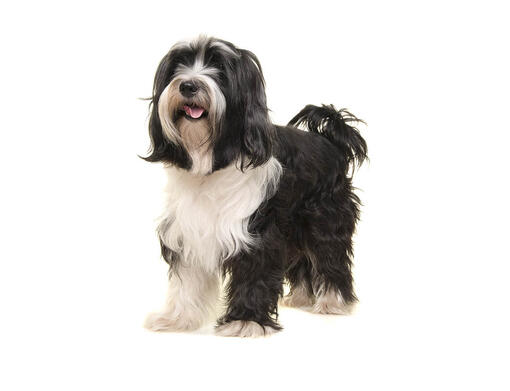
A companion dog developed over 2,000 years ago, the Tibetan Terrier was bred to withstand Tibet’s extreme climate and difficult terrain. Highly intelligent, sensitive and mischievous, the Tibetan Terrier is a loyal, affectionate family dog. Positive, patient training and regular exercise are recommended, and the breed’s profuse, thick coat requires weekly grooming.
DID YOU KNOW? Not actually a terrier, the Tibetan Terrier was named because of his terrier-like size.
ALSO KNOWN AS: Tsang Apso, Dokhi Apso
The need-to-know
- Dog suitable for non-experienced owners
- Basic training required
- Enjoys active walks
- Enjoys walking one to two hours a day
- Small dog
- Minimum drool
- Requires grooming daily
- Non hypoallergenic breed
- Very vocal dog
- Guard dog. Barks and alerts
- May require training to live with other pets
- Great family dog
Personality

A good-natured, happy and outgoing dog, the Tibetan Terrier is alert and game. He is naturally reserved with strangers but loyal and affectionate to his loved ones. A fun-loving companion, Tibetan Terriers are bouncy, larger-than-life characters and can make a super family dog.
History and Origins

He might be called a Tibetan Terrier, but this dog has never been used in the traditional Terrier breed role of going to ground after prey. Instead the Tibetan Terrier dog breed, or TT, was a herding dog, and, when necessary, guard. Kept in monasteries and a companion to the monks, he was known as The Holy Dog of Tibet and reached the attention of the west when, in 1922, a TT puppy was given to Dr Agnes Greig, a British doctor working in India, as thanks for saving a Tibetan woman's life.
Nutrition and Feeding

Small dogs have a fast metabolism, meaning they burn energy at a high rate, although their small stomachs mean that they must eat little and often. Small-breed foods are specifically designed with appropriate levels of key nutrients and smaller kibble sizes to suit smaller mouths. This also encourages chewing and improves digestion.
Exercise

A lively dog, this Tibetan dog breed enjoys his exercise and needs about an hour a day, though he will happily accept more if it's offered. He takes well to training and enjoys spending quality time with his family, and so loves taking part in fun canine hobbies. As with any long-coated dog, do check him over after a walk, to remove any twigs or leaves that might have been swept up along the way!
Other Information

Health and common issues
The Tibetan Terrier is generally a healthy breed. As with many breeds, they can sometimes suffer from hereditary eye disorders, and hip dysplasia (a condition that can lead to mobility problems). Eye testing and hip scoring of dogs prior to breeding is therefore important. Like many small breeds, they can also suffer from kneecaps that may temporarily slip out of place (luxating patellas).
Best family dog breeds
While many dogs are traditionally thought of as being good with children , all dogs and children need to be taught to get on with and respect each other, and be safe together. Even so, dogs and young children should never be left alone together and adults should supervise all interactions between them.